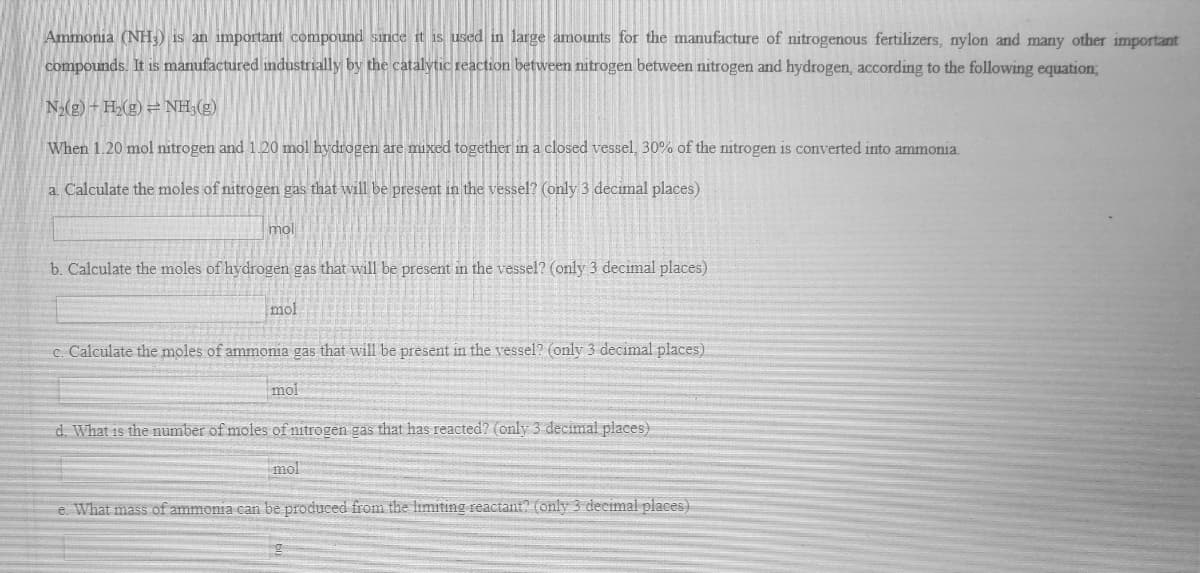Ammonia (NH) is an important compound since it is used in large amounts for the manufacture of nitrogenous fertilizers, nylon and many other important compounds. It is manufactured industrially by the catalytic reaction between nitrogen between nitrogen and hydrogen, according to the following equation; N;(g)+H>(g)=NH;(g) When 1.20 mol nitrogen and 1.20 mol hydrogen are mixed together in a closed vessel, 30% of the nitrogen is converted into ammonia. a Calculate the moles of nitrogen gas that will be present in the vessel? (only 3 decimal places)
Ammonia (NH) is an important compound since it is used in large amounts for the manufacture of nitrogenous fertilizers, nylon and many other important compounds. It is manufactured industrially by the catalytic reaction between nitrogen between nitrogen and hydrogen, according to the following equation; N;(g)+H>(g)=NH;(g) When 1.20 mol nitrogen and 1.20 mol hydrogen are mixed together in a closed vessel, 30% of the nitrogen is converted into ammonia. a Calculate the moles of nitrogen gas that will be present in the vessel? (only 3 decimal places)
World of Chemistry, 3rd edition
3rd Edition
ISBN:9781133109655
Author:Steven S. Zumdahl, Susan L. Zumdahl, Donald J. DeCoste
Publisher:Steven S. Zumdahl, Susan L. Zumdahl, Donald J. DeCoste
Chapter9: Chemical Quantities
Section: Chapter Questions
Problem 50A
Related questions
Question

Transcribed Image Text:Ammonia (NH3) is an important compound since it is used in large amounts for the manufacture of nitrogenous fertilizers, nylon and many other important
compounds. It is manufactured industrially by the catalytic reaction between nitrogen between nitrogen and hydrogen, according to the following equation,
N2(g) + H2(g) = NH;(g)
When 1.20 mol nitrogen and 1.20 mol hydrogen are mixed together in a closed vessel, 30% of the nitrogen is converted into ammonia.
a Calculate the moles of nitrogen gas that will be present in the vessel? (only 3 decimal places)
mol
b. Calculate the moles of hydrogen gas that will be present in the vessel? (only 3 decimal places)
mol
c. Calculate the moles of ammonia gas that will be present in the vessel? (only 3 decimal places)
mol
d What is the number of moles of nitrogen gas that has reacted? (only 3 decimal places)
mol
e. What mass of ammonia can be produced from the limiting reactant? (only 3 deceimal places)
Expert Solution
This question has been solved!
Explore an expertly crafted, step-by-step solution for a thorough understanding of key concepts.
This is a popular solution!
Trending now
This is a popular solution!
Step by step
Solved in 2 steps with 1 images

Knowledge Booster
Learn more about
Need a deep-dive on the concept behind this application? Look no further. Learn more about this topic, chemistry and related others by exploring similar questions and additional content below.Recommended textbooks for you

World of Chemistry, 3rd edition
Chemistry
ISBN:
9781133109655
Author:
Steven S. Zumdahl, Susan L. Zumdahl, Donald J. DeCoste
Publisher:
Brooks / Cole / Cengage Learning

General Chemistry - Standalone book (MindTap Cour…
Chemistry
ISBN:
9781305580343
Author:
Steven D. Gammon, Ebbing, Darrell Ebbing, Steven D., Darrell; Gammon, Darrell Ebbing; Steven D. Gammon, Darrell D.; Gammon, Ebbing; Steven D. Gammon; Darrell
Publisher:
Cengage Learning

Chemistry: The Molecular Science
Chemistry
ISBN:
9781285199047
Author:
John W. Moore, Conrad L. Stanitski
Publisher:
Cengage Learning

World of Chemistry, 3rd edition
Chemistry
ISBN:
9781133109655
Author:
Steven S. Zumdahl, Susan L. Zumdahl, Donald J. DeCoste
Publisher:
Brooks / Cole / Cengage Learning

General Chemistry - Standalone book (MindTap Cour…
Chemistry
ISBN:
9781305580343
Author:
Steven D. Gammon, Ebbing, Darrell Ebbing, Steven D., Darrell; Gammon, Darrell Ebbing; Steven D. Gammon, Darrell D.; Gammon, Ebbing; Steven D. Gammon; Darrell
Publisher:
Cengage Learning

Chemistry: The Molecular Science
Chemistry
ISBN:
9781285199047
Author:
John W. Moore, Conrad L. Stanitski
Publisher:
Cengage Learning

Chemistry for Engineering Students
Chemistry
ISBN:
9781285199023
Author:
Lawrence S. Brown, Tom Holme
Publisher:
Cengage Learning

Chemistry for Engineering Students
Chemistry
ISBN:
9781337398909
Author:
Lawrence S. Brown, Tom Holme
Publisher:
Cengage Learning

Chemistry & Chemical Reactivity
Chemistry
ISBN:
9781337399074
Author:
John C. Kotz, Paul M. Treichel, John Townsend, David Treichel
Publisher:
Cengage Learning